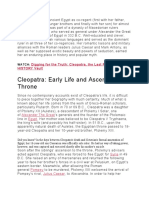0 ratings0% found this document useful (0 votes)
21 viewsGreek Rule: Ptolemaic Kingdom
Greek Rule: Ptolemaic Kingdom
Uploaded by
Alicia NhsThe Ptolemaic Kingdom was a powerful Hellenistic state centered in Egypt from 323 BC to 30 BC. It extended from Syria in the east to Cyrene in the west, and south to Nubia. Alexandria served as the capital and center of Greek culture. Later Ptolemies adopted Egyptian traditions like portrayals in art and participation in religion to gain acceptance. The last Ptolemaic ruler was Cleopatra, who committed suicide after her lover Mark Antony's death following the Roman conquest of Egypt. The Ptolemies faced rebellions and foreign/civil wars, leading to decline and annexation by Rome, though Hellenistic culture continued in Egypt for some time.
Copyright:
© All Rights Reserved
Available Formats
Download as DOCX, PDF, TXT or read online from Scribd
Greek Rule: Ptolemaic Kingdom
Greek Rule: Ptolemaic Kingdom
Uploaded by
Alicia Nhs0 ratings0% found this document useful (0 votes)
21 views1 pageThe Ptolemaic Kingdom was a powerful Hellenistic state centered in Egypt from 323 BC to 30 BC. It extended from Syria in the east to Cyrene in the west, and south to Nubia. Alexandria served as the capital and center of Greek culture. Later Ptolemies adopted Egyptian traditions like portrayals in art and participation in religion to gain acceptance. The last Ptolemaic ruler was Cleopatra, who committed suicide after her lover Mark Antony's death following the Roman conquest of Egypt. The Ptolemies faced rebellions and foreign/civil wars, leading to decline and annexation by Rome, though Hellenistic culture continued in Egypt for some time.
Original Description:
e3
Original Title
Egypt 3
Copyright
© © All Rights Reserved
Available Formats
DOCX, PDF, TXT or read online from Scribd
Share this document
Did you find this document useful?
Is this content inappropriate?
The Ptolemaic Kingdom was a powerful Hellenistic state centered in Egypt from 323 BC to 30 BC. It extended from Syria in the east to Cyrene in the west, and south to Nubia. Alexandria served as the capital and center of Greek culture. Later Ptolemies adopted Egyptian traditions like portrayals in art and participation in religion to gain acceptance. The last Ptolemaic ruler was Cleopatra, who committed suicide after her lover Mark Antony's death following the Roman conquest of Egypt. The Ptolemies faced rebellions and foreign/civil wars, leading to decline and annexation by Rome, though Hellenistic culture continued in Egypt for some time.
Copyright:
© All Rights Reserved
Available Formats
Download as DOCX, PDF, TXT or read online from Scribd
Download as docx, pdf, or txt
0 ratings0% found this document useful (0 votes)
21 views1 pageGreek Rule: Ptolemaic Kingdom
Greek Rule: Ptolemaic Kingdom
Uploaded by
Alicia NhsThe Ptolemaic Kingdom was a powerful Hellenistic state centered in Egypt from 323 BC to 30 BC. It extended from Syria in the east to Cyrene in the west, and south to Nubia. Alexandria served as the capital and center of Greek culture. Later Ptolemies adopted Egyptian traditions like portrayals in art and participation in religion to gain acceptance. The last Ptolemaic ruler was Cleopatra, who committed suicide after her lover Mark Antony's death following the Roman conquest of Egypt. The Ptolemies faced rebellions and foreign/civil wars, leading to decline and annexation by Rome, though Hellenistic culture continued in Egypt for some time.
Copyright:
© All Rights Reserved
Available Formats
Download as DOCX, PDF, TXT or read online from Scribd
Download as docx, pdf, or txt
You are on page 1of 1
Greek rule[edit]
Ptolemaic Kingdom[edit]
Main article: Ptolemaic Kingdom
The Greek Ptolemaic queen Cleopatra and her son by Julius Caesar, Caesarion, at the Dendera Temple
complex.
The Ptolemaic Kingdom was a powerful Hellenistic state extending from southern Syria in the east,
to Cyrene to the west, and south to the frontier with Nubia. Alexandria became the capital city and a
center of Greek culture and trade. To gain recognition by the native Egyptian populace, they named
themselves as the successors to the Pharaohs. The later Ptolemies took on Egyptian traditions, had
themselves portrayed on public monuments in Egyptian style and dress, and participated in Egyptian
religious life.[12][13]
The last ruler from the Ptolemaic dynasty was Cleopatra, who committed suicide following the burial
of her lover Mark Antony, who had died in her arms (from a self-inflicted stab wound)
after Augustus had captured Alexandria and her mercenary forces had fled.
The Ptolemies faced rebellions of native Egyptians, often caused by an unwanted regime, and were
involved in foreign and civil wars that led to the decline of the kingdom and its annexation by Rome.
Nevertheless, Hellenistic culture continued to thrive in Egypt well after the Muslim conquest. The
native Egyptian/Coptic culture continued to exist as well (the Coptic language itself was Egypt's most
widely spoken language until at least the 10th century).
You might also like
- Antony and CleopatraDocument3 pagesAntony and CleopatraAlexandra NeculaNo ratings yet
- CleopatraDocument4 pagesCleopatraMarilynNo ratings yet
- Cleopatra: Early Life and Ascension To Throne: Digging For The Truth: Cleopatra, The Last Pharaoh On History VaultDocument5 pagesCleopatra: Early Life and Ascension To Throne: Digging For The Truth: Cleopatra, The Last Pharaoh On History VaultGayle Omisol100% (1)
- Egyptology Articles Herbs ArticlesDocument5 pagesEgyptology Articles Herbs ArticleskarthikNo ratings yet
- CleopatraDocument9 pagesCleopatraAugusto ChocobarNo ratings yet
- The Life of The Last Pharaoh of EgyptDocument16 pagesThe Life of The Last Pharaoh of EgyptShanelle BarrilNo ratings yet
- CleopartaDocument6 pagesCleopartaanon-292377No ratings yet
- Cleopatra InfoDocument7 pagesCleopatra Info17154.westieNo ratings yet
- Cleopatra BiographyDocument4 pagesCleopatra Biographydam1123No ratings yet
- Final Cleopatra InfoDocument2 pagesFinal Cleopatra Info17154.westieNo ratings yet
- 604 CleopatraDocument2 pages604 CleopatraabilodeauNo ratings yet
- The Background of CleopatraDocument2 pagesThe Background of Cleopatraabeer.rashidalikhanNo ratings yet
- Cleopatra Grade 9 Informational Passage by HmagramDocument2 pagesCleopatra Grade 9 Informational Passage by HmagramHeidiElmoustakimNo ratings yet
- CleaopatraDocument1 pageCleaopatrashalakasatishNo ratings yet
- Christopher CruiseDocument3 pagesChristopher CruisehuythuleNo ratings yet
- AnswersDocument4 pagesAnswersMaika Lyn QuitainNo ratings yet
- Cleopatra Was Not Egyptian.: Cleopatra's Beauty Wasn't Her Biggest AssetDocument4 pagesCleopatra Was Not Egyptian.: Cleopatra's Beauty Wasn't Her Biggest AssetMavrick Xymon CalimotNo ratings yet
- YearDocument1 pageYearjananeyNo ratings yet
- Ptolemaic Period (332-30 BC) : History of Ptolemaic Egypt Ptolemaic KingdomDocument2 pagesPtolemaic Period (332-30 BC) : History of Ptolemaic Egypt Ptolemaic KingdomJerome BrusasNo ratings yet
- 6 2 Cleopatra Wily Queen of EgyptDocument1 page6 2 Cleopatra Wily Queen of Egyptapi-98469116No ratings yet
- Cleopatra & Marcus AntoniusDocument7 pagesCleopatra & Marcus AntoniusLili TigerNo ratings yet
- Cleopatra VII : The Last Pharaoh of Ancient Egypt - History Picture Books | Children's Ancient HistoryFrom EverandCleopatra VII : The Last Pharaoh of Ancient Egypt - History Picture Books | Children's Ancient HistoryNo ratings yet
- The Hellenistic WorldDocument9 pagesThe Hellenistic Worldkinzamir272No ratings yet
- Ptolemaic Kingdom: PtolemaïkDocument26 pagesPtolemaic Kingdom: Ptolemaïkapollodoro87No ratings yet
- Ptolemaic KingdomDocument4 pagesPtolemaic KingdomGatooNo ratings yet
- Jahde Cleopatra and Her Life and Time Final DraftDocument5 pagesJahde Cleopatra and Her Life and Time Final DraftjboisgirardNo ratings yet
- CleopatraDocument3 pagesCleopatrakhanifNo ratings yet
- Cleopatra: Cleopatra VII Philopator (Koinē GreekDocument49 pagesCleopatra: Cleopatra VII Philopator (Koinē GreekTamer BhuiyannNo ratings yet
- Ancient History Notes - CleopatraDocument28 pagesAncient History Notes - CleopatraloliamfarNo ratings yet
- Ptolemaic Kingdom - WikipediaDocument28 pagesPtolemaic Kingdom - WikipedialosthopeornotNo ratings yet
- History CleopetraDocument2 pagesHistory CleopetraluqmanbrainNo ratings yet
- Thesis On Cleopatra ViiDocument4 pagesThesis On Cleopatra Viibrittneysimmonssavannah100% (2)
- Ancient Egypt ResearchDocument11 pagesAncient Egypt ResearchFranchesca Ysabel MapeNo ratings yet
- Study Notes - Cleopatra VIIDocument3 pagesStudy Notes - Cleopatra VIIbeastboygo33No ratings yet
- Ptolemaic EgyptDocument12 pagesPtolemaic Egyptapi-334420312No ratings yet
- CleopatraDocument4 pagesCleopatraAnid PeergNo ratings yet
- Ptolemaic KingdomDocument16 pagesPtolemaic KingdomValentin MateiNo ratings yet
- Exp Egyptian AchievementsDocument7 pagesExp Egyptian Achievementsapi-214066507No ratings yet
- What's Their Story?Document33 pagesWhat's Their Story?u4416112No ratings yet
- Antony and CleopatraDocument6 pagesAntony and Cleopatravenkatvasu08No ratings yet
- Women HistoryDocument2 pagesWomen HistoryBea MunchNo ratings yet
- Ptolemaic Kingdom - WikipediaDocument27 pagesPtolemaic Kingdom - WikipediaAmogh TalpallikarNo ratings yet
- HIST1421 Learning Journal Unit 5Document3 pagesHIST1421 Learning Journal Unit 5Aungsoemoe GLNo ratings yet
- Women of Ancient EgyptDocument3 pagesWomen of Ancient EgyptsuzyNo ratings yet
- CleopatraDocument17 pagesCleopatraChristopher SmithNo ratings yet
- Cleopatra: Cleopatra VII Philopator (Koinē GreekDocument307 pagesCleopatra: Cleopatra VII Philopator (Koinē GreekKurt dela cruzNo ratings yet
- Cleopatra's AccomplishmentsDocument1 pageCleopatra's Accomplishmentsapi-282348394No ratings yet
- CleopatraDocument5 pagesCleopatraDiana GonzálezNo ratings yet
- Channeling CleopatraDocument2 pagesChanneling Cleopatrateacher vinNo ratings yet
- 0.5 Classical GreeceDocument19 pages0.5 Classical GreeceDantdm ExtraNo ratings yet
- TestDocument1 pageTestniggalationsNo ratings yet
- Performance Task in UCSPDocument3 pagesPerformance Task in UCSPkmarisseeNo ratings yet
- Cleopatra the Great: The Woman Behind the LegendFrom EverandCleopatra the Great: The Woman Behind the LegendRating: 3.5 out of 5 stars3.5/5 (9)
- 10 Greatest Leaders in The History of World CivilizationDocument7 pages10 Greatest Leaders in The History of World CivilizationardiNo ratings yet
- Africa History TruthDocument8 pagesAfrica History TruthJojo T. Will100% (1)
- CleopatraDocument1 pageCleopatraisabelaristizabal43No ratings yet
- Charlie Thorne and the Curse of CleopatraFrom EverandCharlie Thorne and the Curse of CleopatraRating: 4.5 out of 5 stars4.5/5 (12)
- Kandyan Period (1594-1815) : Kingdom of KandyDocument2 pagesKandyan Period (1594-1815) : Kingdom of KandyAlicia NhsNo ratings yet
- Middle Ages: Medieval Muslim AlgeriaDocument2 pagesMiddle Ages: Medieval Muslim AlgeriaAlicia NhsNo ratings yet
- Albania 4Document1 pageAlbania 4Alicia NhsNo ratings yet
- Post-Conflict PeriodDocument1 pagePost-Conflict PeriodAlicia NhsNo ratings yet
- Sri Lanka (1948-Present) : IndependenceDocument1 pageSri Lanka (1948-Present) : IndependenceAlicia NhsNo ratings yet
- Polonnaruwa Period Kingdom of PolonnaruwaDocument2 pagesPolonnaruwa Period Kingdom of PolonnaruwaAlicia NhsNo ratings yet
- Prehistory: Prehistory of Sri LankaDocument1 pagePrehistory: Prehistory of Sri LankaAlicia NhsNo ratings yet
- School Form 1 (SF 1) School RegisterDocument8 pagesSchool Form 1 (SF 1) School RegisterAlicia NhsNo ratings yet
- School Form 1 (SF 1) School RegisterDocument8 pagesSchool Form 1 (SF 1) School RegisterAlicia NhsNo ratings yet
- School Form 1 (SF 1) School RegisterDocument6 pagesSchool Form 1 (SF 1) School RegisterAlicia NhsNo ratings yet
- Hellenistic and Roman Periods (323 BC - 4th Century AD)Document2 pagesHellenistic and Roman Periods (323 BC - 4th Century AD)Alicia NhsNo ratings yet
- Greece: Hellenic RepublicDocument5 pagesGreece: Hellenic RepublicAlicia NhsNo ratings yet
- SF1 - 2021 - Grade 8 Year II RIZALDocument8 pagesSF1 - 2021 - Grade 8 Year II RIZALAlicia NhsNo ratings yet
- Medieval Period (4th - 15th Century) : Byzantine Greece Frankokratia Byzantine Empire Fourth CrusadeDocument2 pagesMedieval Period (4th - 15th Century) : Byzantine Greece Frankokratia Byzantine Empire Fourth CrusadeAlicia NhsNo ratings yet









































































